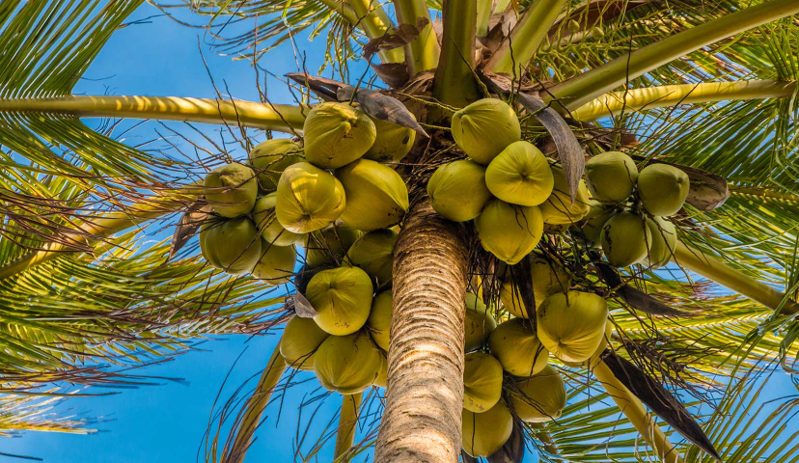Cocos nucifera
Overview
The coconut, belonging to the palm family and the genus Cocos, is an important tropical fruit and oil crop. The oldest discovered fossil of the coconut, dating back to the Paleocene period (approximately 56-66 million years ago), was found in India. The fruit of the coconut is highly cherished and beloved. Presently, coconut trees are cultivated in 93 countries, encompassing Central and South America, East and West Africa, Southeast Asia, and the Pacific Islands. The total cultivated area exceeds 12 million hectares.

Geographical Distribution
Coconuts are primarily distributed from between 23°S and 23°N latitudes, mostly in Africa, Latin America, Asia and equatorial coastal areas. The main coconut production regions include Sri Lanka, Malaysia, India, and the Philippines.
In China, coconuts are cultivated in small quantities in tropical areas such as Hainan Province, Taiwan Province, southern Yunnan, the southern islands of Guangdong, and the Leizhou Peninsula. Among these, Hainan Province accounts for 99% of coconut cultivation in China.
Application
- Edible use: The unripe endosperm of the coconut can be eaten as a fruit. The ripe coconut flesh can be used to extract oil and for the production of candies and pastries.
- Fuel use: The endocarp of the coconut is utilized as an alternative fuel source in the form of charcoal.
- Healthcare: Coconuts are also known for their relaxing properties, diuretic effects, and their ability to tonify the spleen and stomach, as well as alleviate intestinal issues.
- Other industrial raw materials: The endocarp of the coconut serves as a source of industrial fiber, specifically coir fiber.
Genome sequencing
"Hainan Tall" is a widely cultivated coconut cultivar in Hainan, China. The Institute of Coconut Research, Chinese Academy of Tropical Agricultural Sciences (CATAS), Institute of Tropical Biotechnology (ITB), UW Genetics, and the French Center for International Cooperation and Research in Agriculture (CIRAD) collaborated to complete the genome sequencing and sequence analysis. Sequencing the genome of this species using the Illumina HiSeq 2000 platform generated a total of 419.67 Gb of raw reads, covering the predicted coconut genome length of 2.42 Gb with an estimated read depth of 173.32×. A genome drafts with a total length of 2.20 Gb, representing 90.91% of the genome, were generated. The scaffold N50 was 418 Kb. During the gene annotation process, 280,039 protein-coding genes were identified.
In 2021, Yang et al. from the Chinese Academy of Tropical Agricultural Sciences and their collaborators utilized the genotyping-by-sequencing (GBS) technology in a backcross mapping population to generate a linkage map. The resulting dense linkage map consisted of 8,402 single nucleotide polymorphisms (SNPs) and was specifically designed to facilitate the assembly of the large coconut genome (2.42 Gbp, 2n=32) into 16 pseudomolecules.
In 2022, the Coconut Research Institute of the Chinese Academy of Tropical Agricultural Sciences (CATAS), collaborated with research teams from Hainan University, Guangxi University, and North China University of Technology to map two reference-level coconut genomes. The researchers used a combination of nanopore sequencing, Hi-C, and Illumina technologies to sequence and assemble two high-quality coconut reference genomes. For the Cn.tall samples, 227 Gb of Nanopore sequencing reads (~114×), 124 Gb of Illumina reads for genome correction, and 213 Gb of high-throughput chromosome conformation capture (Hi-C) reads were generated and applied to genome assembly. For Cn.dwarf, a corresponding set of 249 Gb Nanopore sequencing reads (~102×), 126 Gb of Illumina reads and 270 Gb of Hi-C reads were obtained. The reassembly resulted in a genome size of 2.40 Gb for Cn.tall and 2.39 Gb for Cn.dwarf, which closely matched the estimated genome sizes of approximately 2.42 Gb and 2.44 Gb, respectively, based on k-mer distribution analysis. The contig N50 values were 2.9 Mb and 14.3 Mb for Cn.tall and Cn.dwarf, respectively. The researchers utilized Hi-C data to order and orient the resulting allelic genomes, enabling chromosome-level genome assembly. Ultimately, they predicted the presence of 29,897 protein-coding genes in Cn.tall and 28,111 protein-coding genes in Cn.dwarf.
Reference
1.冯美利,李杰,王必尊. 我国椰子综合研究进展概述[J]. 中国热带农业,2007(5):30-31. DOI:10.3969/j.issn.1673-0658.2007.05.015.
2.卢丽兰,刘蕊,肖勇,等. 椰子种质资源、栽培与利用研究进展[J]. 热带作物学报,2021,42(6):1795-1803. DOI:10.3969/j.issn.1000-2561.2021.06.040.
3.高正清. 椰子树栽培管理技术[J]. 云南林业科技,2003(1):40-42. DOI:10.3969/j.issn.1672-8246.2003.01.011.
4.肖红,易美华. 椰子的开发利用[J]. 海南大学学报(自然科学版),2003,21(2):183-189. DOI:10.3969/j.issn.1004-1729.2003.02.022.
5.Xiao Y, Xu P, Fan H, et al. The genome draft of coconut (Cocos nucifera). Gigascience. 2017;6(11):1-11. [OpenLBID: OLB-PM-29048487]
6.Yang Y, Bocs S, Fan H, et al. Coconut genome assembly enables evolutionary analysis of palms and highlights signaling pathways involved in salt tolerance. Commun Biol. 2021;4(1):105. [OpenLBID: OLB-PM-33483627]
7.Wang S, Xiao Y, Zhou ZW, et al. High-quality reference genome sequences of two coconut cultivars provide insights into evolution of monocot chromosomes and differentiation of fiber content and plant height. Genome Biol. 2021;22(1):304. [OpenLBID: OLB-PM-34736486]